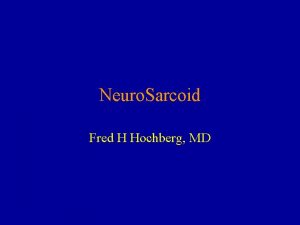EQUINE SARCOID Sarcoids are commonly occurring equine skin


- Slides: 2

EQUINE SARCOID Sarcoids are commonly occurring equine skin tumours that have been heart-ache for horses and their owners for centuries. Sarcoids are the most common skin tumour of the horse worldwide. Although common, sarcoids vary greatly in their size and appearance, the nature in which they grow and potentially spread and the way they respond to treatment. It is this variability that makes sarcoids such a challenge for both owners and veterinarians. Some Important Sarcoid Facts Sarcoids are common; geldings appear more frequently affected. All equid species are susceptible - even donkeys and zebras. Although sarcoids are a type of tumour (cancer) they do not metastasise (spread to internal organs). Once a sarcoid horse, always a sarcoid horse! A horse with one sarcoid is likely to develop more. Sarcoids can develop anywhere on the horse’s skin, but more common sites include the chest, groin, sheath and face (especially around the eyes and mouth). Sarcoids are likely to recur, regardless of treatment. Trauma of any nature to a sarcoid is likely to aggravate it. No two sarcoids are the same; each sarcoid needs to be assessed on an individual basis. Sarcoids can be unpredictable in all aspects of their development and treatment. There is no ‘magic cure’ for sarcoids. Types of Sarcoids There are 6 broad classifications for equine sarcoids; occult, verrucous (warty), nodular, fibroblastic, mixed and malevolent. It must be remembered that no two sarcoids are the same and sarcoids definitely don’t read the text book, so many individual tumors may contain characteristics of several different types. Nodular Sarcoids. Fibroblastic Sarcoids � Mixed Sarcoids Occult Sarcoids Malevolent Sarcoids Verrucous Sarcoids Histological Features Histologically, most lesions are composed of a thickened epidermis with prominent epithelial pegs that extend into a dermal proliferation of fibroblasts that are arrangedin whorls, tangles, or herringbone patterns and contain small amounts of collagen. Nuclear pleomorphism and mitoses vary, but can be pronounced in rapidly growing or recurrent tumors. There can be difficulty differentiating some sarcoids from fibrosarcomas or nerve sheathtumors, especially if there has been ulceration with loss ofthe distinctive epidermal component. However, these lattertumors are thought to be rare in the horse.




